
Showing posts with label aquaculture. Show all posts
Showing posts with label aquaculture. Show all posts
Sunday, May 15, 2011
Saturday, October 31, 2009
The oceans' bounty

Perhaps one of the best ways to catch a glimpse of marine biodiversity is to visit your local fish market. Jurong Fishery Port is no Tsukiji, but on your average early morning visit, it's hard not to be stunned at the sheer volume and diversity of marine life.

All manner of fishes, crustaceans, and other forms of seafood from all over the region arrive here, to be auctioned off and sold, then shipped to markets scattered throughout Singapore.

And yet, viewing the riches of the oceans, marvelling at the kaleidoscope of shapes and colours, one begins to wonder just how much longer we have until we truly reach the end of the line.

With numerous fisheries on the decline, and others on the brink of collapse, it boggles the mind to read about how acute myopia still cripples efforts to save the very resource so many communities depend on.

Aquaculture can provide solutions, but also creates many problems if mismanaged, with greater consequences for vital habitats.

Indeed, more and more are waking up to the fact that the oceans are far from bottomless, and that continued plunder to sustain our insatiable greed will only create undersea deserts.

The need for consumers to make a stand on sustainable seafood is a reality. By choosing what seafood we eat, and what we abstain from eating, we are making decisions that will have trickle-down effects on the suppliers. When demand drops, there will be less of a need to continue to pillage the ever-shrinking fish stocks.

It's a concept that hasn't quite taken root here in the region, although steps are being made to rectify this. As a nation that obviously loves seafood, it's about time we became more responsible and ecologically conscious in what we choose to eat.
Labels:
aquaculture,
arthropods,
fish,
fishing,
Jurong,
marine,
resources
Monday, October 26, 2009
Monday Morgue: 26th October 2009
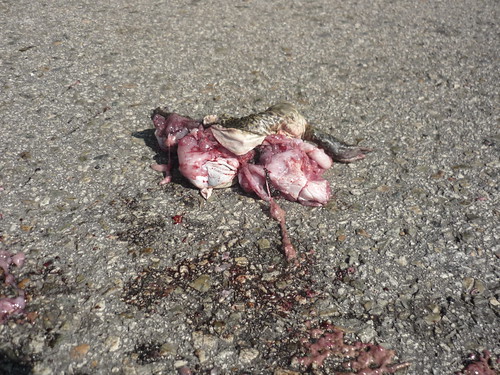
American bullfrog (Lithobates catesbeianus)
Kranji, 20th December 2008
This is the very same bullfrog from this post, after it had been run over by a couple more vehicles.
Ecology Asia
Wildlife Singapore
Global Invasive Species Database
AmphibiaWeb
Animal Diversity Web
National Geographic
Saturday, June 27, 2009
Weaver bird nests spotted at Lim Chu Kang fish farm

STOMPer Ornithologist went to the fish farm at Lim Chu Kang and saw several weaver bird nests and a school of Japanese carp.
Sharing his findings, he says:
"These pictures were taken at a fish farm at Lim Chu Kang Lane 6.
"At the entrance of the farm I noticed several weaver bird nests on a tree.
"The weaver birds are gregarious birds which breed colonially. The birds build their nests together, and usually the male birds weave the nests and use them as a form of display to lure the females.
"I also saw a school of kois in a pond. The koi is also known as the Japanese carp.
"Kois have no stomachs. What they do have are expandable small intestines and they function as a pseudo stomach.
"They have small teeth in the back of the throat that they use to crush any crustaceans they may ingest.
"Kois are 'pigs' of the water because they love and eat anything they can find. They can consume up to 2% of its body in a day."
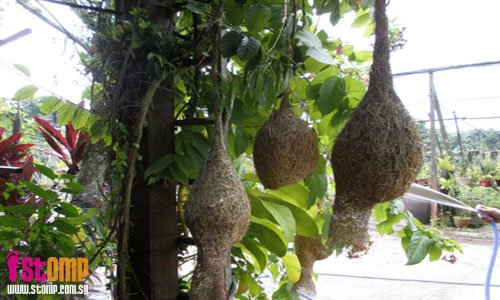
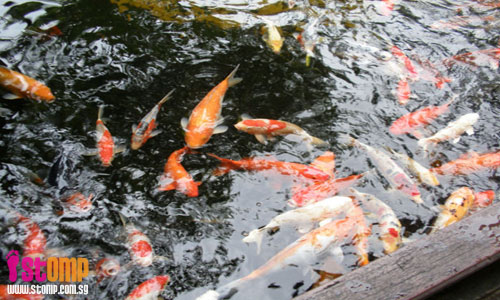
More nests of the baya weaver (Ploceus philippinus), I see. I wonder if they are still in use.
I was surprised to learn that common carp (Cyprinus carpio) actually lack a proper stomach. Instead, the oesophagus opens up into the lower intestine.
According to this link on digestion in teleost fishes:
Carp lack a stomach, but have a long intestine which winds extensively throughout the visceral cavity. The gall bladder rests on the dorsal surface of the anterior midgut and the bile duet opens into the intestine just anterior to the gall bladder. In addition, the liver has no specific shape, but seems to serve as packing material around the intestine. Food seems to be ingested in small particles in a relatively steady stream instead of intermittently in large units, so the storage function of a stomach probably is not missed. With the liver filling all the available visceral space, there would be no room for accommodating the stomach expansion of a large meal anyway.
By the way, koi is both singular and plural. There is no such word as 'kois'.
Labels:
aquaculture,
birds,
fish,
Lim Chu Kang,
pets
Monday, June 22, 2009
Monday Morgue: 22nd June 2009
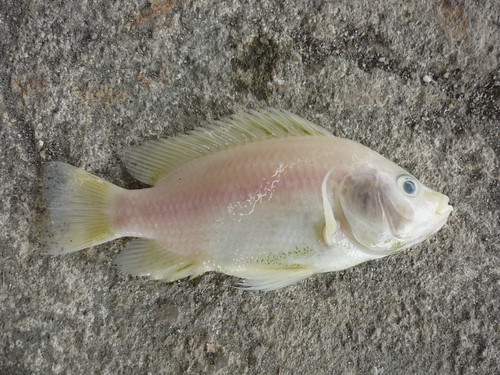
Tilapia (Oreochromis sp.)
Lim Chu Kang, 30th December 2008
This probable hybrid tilapia was found floating in a concrete tank full of its live counterparts at Jurong Frog Farm.
Global Invasive Species Database
The tilapia species commonly encountered in our ponds, rivers and canals, and even in our mangroves and estuaries is likely to be the Mozambique tilapia (Oreochromis mossambicus).
A Guide to the Freshwater Fishes of Singapore
A Guide to Common Marine Fishes of Singapore
A Guide to the Mangroves of Singapore
FishBase
Global Invasive Species Database
However, many tilapia raised for aquaculture in Singapore are hybrids between the Mozambique tilapia, blue tilapia (Oreochromis aureus) and Nile tilapia (Oreochromis niloticus). Consequently, it is probable that many tilapia populations found in the wild also contain the latter 2 species, as well as captive-bred hybrids (such as the 'red tilapia').
Blue tilapia (Oreochromis aureus)
FishBase
Global Invasive Species Database
Nile tilapia (Oreochromis niloticus)
FishBase
Global Invasive Species Database
Monday, June 15, 2009
Monday Morgue: 15th June 2009
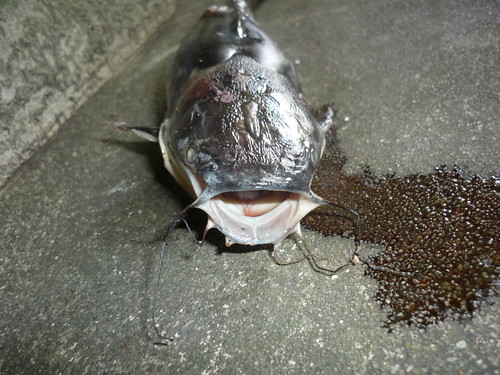
African walking catfish (Clarias gariepinus)
Khai Seng Trading & Fish Farm, 20th December 2008
At this fish farm, there are several concrete tanks where these catfish are raised. Every once in a while, a catfish jumps a little too high, and promptly finds itself on the dry concrete walkway. Although walking catfish are able to survive out of water for some time, they will eventually perish if they are unable to remain sufficiently moist. This was one unfortunate individual that wasn't retrieved by a farm worker in time.
FishBase
PlanetCatfish
Animal Diversity Web
Artificial Reproduction and Pond Rearing of the African Catfish Clarias gariepinus in Sub-Saharan Africa - A Handbook
Labels:
aquaculture,
fish,
introduced species,
Lim Chu Kang
Monday, June 1, 2009
Monday Morgue: 1st June 2009

American bullfrog (Lithobates catesbeianus)
Kranji, 20th December 2008
When I first encountered this bullfrog, it was still very much alive, and sitting by the road just outside Khai Seng Trading & Fish Farm. No prizes for guessing where it escaped from.
After some time, the bullfrog attempted to cross the road, and several near misses later, it was finally struck by a passing car. A horrible end, even for an undesirable invasive species.
Ecology Asia
Wildlife Singapore
Global Invasive Species Database
AmphibiaWeb
Animal Diversity Web
National Geographic
Monday, April 6, 2009
Monday Morgue: 6th April 2009
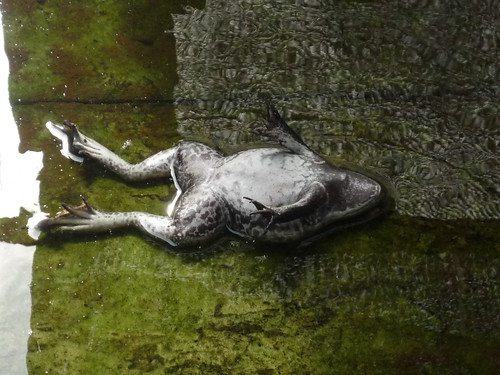
American bullfrog (Lithobates catesbeianus)
Jurong Frog Farm, 30th December 2008
Ecology Asia
Wildlife Singapore
AmphibiaWeb
Checklist of Amphibian Species and Identification Guide
CaliforniaHerps.com
Amphibians and Reptiles of Europe
Animal Diversity Web
National Geographic Animals
Subscribe to:
Posts (Atom)